Geezer Stuff: Enjoyment For The Elderly (2021)

Windows 11, Dorian Gray Edition: Bill Gates just turned 66 years old. Seventy-five year old Gerard Van der Leun of American Digest doesn't think Bill looks good for his age. One of Gerard's posters commented that Gates looks older because "see what an evil heart and deceitful mind will do to ya?" It seems to me that Gates jumped from a geeky-looking college kid to an old man in an instant.
Here's a photo of 78 year-old me taken earlier this month:
I sent the above photo to my high school buddies because I couldn't join them for our 60th Reunion last weekend in Philadelphia. I think that I look younger than Gates - and I'm twelve years older than Bill. I say my prayers daily and try not to be evil.
I hope that the 29 graduates who attended the reunion had a swell time. There are 25 of them in the above photo. To my eyes, all of them look better than Bill Gates. (posted 11/4/21, permalink)
Childhood Mosquito Memories: In Philadelphia, trucks came around fairly often to spray big clouds of DDT (Dichlorodiphenyltrichloroethane) to control the mosquito population.
In Brigantine, NJ, where my parents had a summer home, a Jeep fitted with large tanks came by every evening spraying DDT. Brigantine also used ... (more >>>)
Elkhart Motel Memories: Recently, James Lileks posted a 1960s-era color postcard of the long-gone Holiday Inn in Elkhart, Indiana, which looked like a hundred other Holiday Inns strewn across the Midwest.
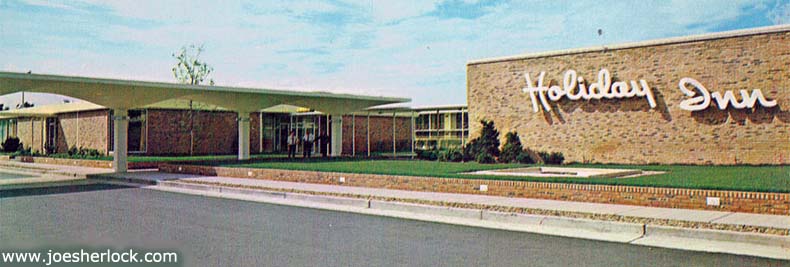
I remembered it well, having stayed there several times in the early 1970s. Elkhart is located 15 miles east of South Bend, Indiana, 110 miles east of Chicago. It was then known as the RV Capital of the World and I was there meeting with new product engineers to discuss the use of plastics in recreational vehicles. And boats - there were several large fiberglass boatbuilders in the area as well.
I began traveling on business in the late 1960s. In those days, if you were traveling to an unfamiliar city, you'd choose one based on the Hotel Redbook (which tended to favor large downtown hotels and didn't usually list motels near the airport) or those 'Take One' paperback directories found in the lobbies of large chain hotels/motels - Holiday Inn, Marriott, Hilton, Ramada Inns, Hyatt, etc.
I tried not to stay at Holiday Inns; some were badly-run, featuring broken televisions, poorly-cleaned rooms, glacially slow and overpriced breakfast service, etc. But, sometimes there were no good alternatives. In those days, Ramada Inns were much better than anything Holiday. If I was lucky, I'd travel to a city that had a Hyatt Regency or Marriott, which were top-of-the-heap in the 1970s. (posted 9/17/21, permalink)
Two Pairs Of Pants With Every Suit: An offer such as this seems silly in today's business casual world. But, during most of the 20th Century, this was a big deal because men typically wore suits to work, to church and to dinner. Typically, workers hung up their suit jackets and worked in shirtsleeves at their desks. They'd put their jackets on for important meetings - with customers or staff. The pants always wore out before the jacket, so the idea of a second pair of matching pants with one's suit purchase was appealing.
Bond Clothing Stores was a men's clothing manufacturing company and retailer, catering to the middle-class consumer. The company was founded in Cleveland, Ohio, in 1914, when Mortimer Slater, with Charles Anson Bond and Lester Cohen, founded the stores as a retail outlet for their suit manufacturing company. During the 1930s and 1940s, it became the largest retail chain of men's clothing in the United States, best known for selling two-pant suits. In 1956, wholly owned manufacturing plants operated at New Brunswick, NJ, New York City, and Rochester, NY. By then, the chain operated nearly 100 outlets from coast-to-coast in principal cities; by the late 1960s there were around 150 Bond retail outlets.
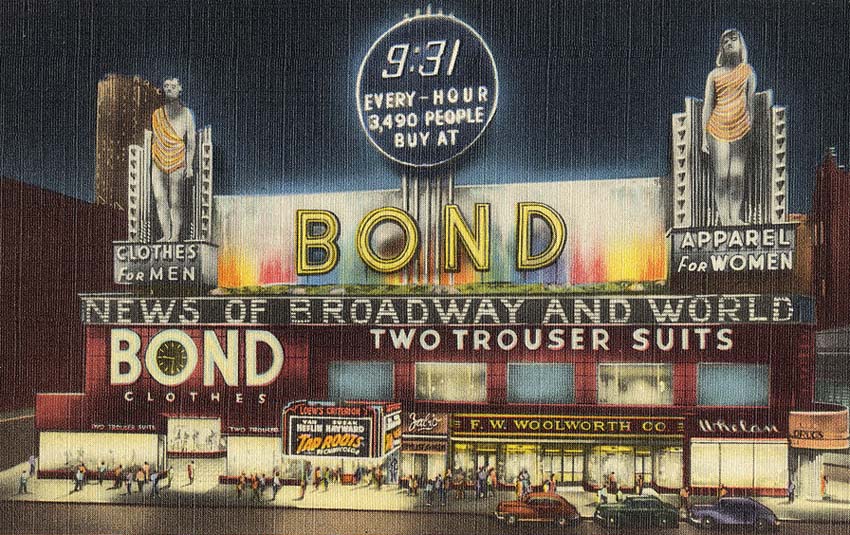
Bond's New York City store was a tourist attraction because of its distinctive sign. Between 1948 and 1954, Bond Clothes operated a massive sign on the east side block of Broadway between 44th and 45th streets in New York's Times Square. The sign had nearly 2 miles of neon and included two 7-story-tall figures, a man and a woman, as bookends. Between the figures, there was a 27-foot-high and 132-foot-wide waterfall with 50,000 gallons of recirculated water. Beneath the waterfall was a 278-foot-long zipper sign with scrolling messages. The Bond zipper was made up of more than 20,000 light bulbs. Above the waterfall was a digital clock with the wording 'Every Hour 3,490 People Buy at Bond'. Some of the sign remained in place to advertise the Bond Stores location until the store's closure in 1977.
During the early part of my business career, I purchased several suits from Bond Clothiers in NE Philadelphia. They were a good value and were very well made for the price. Suits were part of my business life. When I worked in a laboratory, slacks and a sport coat were fine for daily wear, but if we were doing customer training, suits were required. When I worked in a downtown office, suits were de rigueur. On business trips, I favored dark colors - they were less prone to stains if someone spilled coffee on you when flying. I owned dark blue, navy with pinstripes, dark gray and the like. When I had my own business, sport coats were fine for business wear in the Pacific Northwest but I had suits for meetings with banks or big corporations.
I still have a dark blue pinstripe suit but, these days, I only wear it for funerals. With my black Bostonian wingtip dress shoes. Of course, shoes are another subject altogether. (posted 9/1/21, permalink)
Nice Apples:
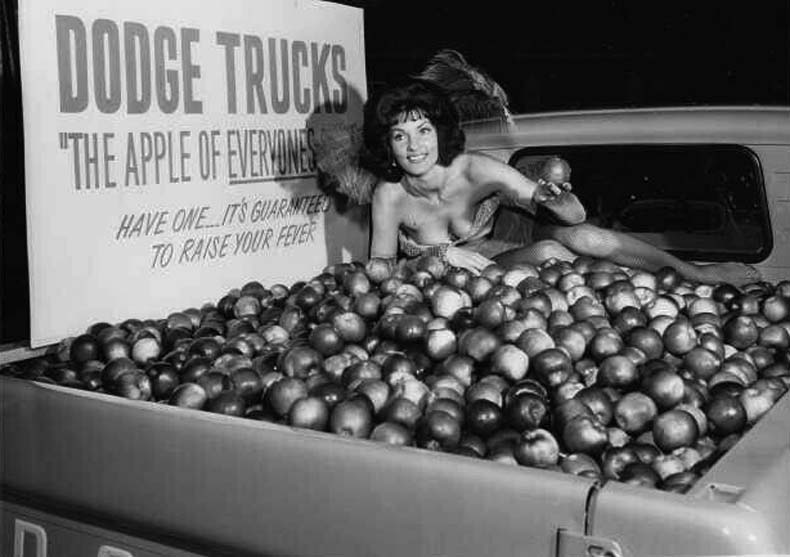
Ripe for picking. (posted 8/16/21, permalink)
'The Swingingest Sexpot In Show Business': That's how a 1963 magazine article described singer Abbe Lane.
|
|
In this 1954 photograph, Abbe poses outside Ciro's, a popular nightclub and celebrity hangout in the 1940s and '50s - located on Sunset Boulevard in West Hollywood, CA. Note the Jaguar XK roadster in the background. During the 1950s and early 60s she worked primarily in nightclubs, usually with Xavier Cugat.
|
Born in 1932, Lane was known for her sexy outfits for the times and sultry style of performing. She attracted attention for her suggestive comments, such as "Jayne Mansfield may turn boys into men, but I take them from there." Abbe became the fourth wife of Latin bandleader and musician Xavier Cugat. She married him in 1952 - he was 32 years her senior. The couple divorced in 1963. Cugat soon married Charro - he was 66, she was 20.
Abbe looked very exotic and could have easily been Spanish - just like Mr. Cugat. But the fact is she was a Jewish girl from Brooklyn, born Abigail Francine Lassman.
In 1957, Lane and Cugat did a short-lived 15-minute television show. I remember watching it - just to see Abbe shake her hips while she sang. That was very exciting for a 13 year-old like me. (posted 8/10/21, permalink)
Funniest Headline Of The 20th Century:
Especially to impress girls. Meccano is the British version of A. C. Gilbert's Erector Sets. (posted 8/4/21, permalink)
Pulling The Cord:
I do. The ones in Philadelphia made a loud buzz. (posted 7/20/21, permalink)
Old-Time Washer: If you've ever wondered where the term 'automatic washer' came from, take a look at its predecessor from 1941. This unit had a manual shift lever for various wash cycles. When the wash was finished, the clothes were run through the attached wringer to squeeze out excess water. Then they were ready to be hung out to dry. These types of washers were still made and sold in the early 1960s, although most of the world had moved on to automatic washers, with automatic water-fill, agitate and spin cycles.
In the 1930s and '40s, these washers could also be purchased with a small gasoline engine in place of the electric motor for homes which lacked electricity.
In Northeast Philadelphia, there was a giant Sears & Roebuck nine-story complex, over 25 million square feet, which included ... (more >>>)
Spud Queen: Presenting Miss Idaho Potato of 1935:
Don't get too excited - she's probably 104 years-old by now. (posted 7/1/21, permalink)
Did Anyone Believe This Ad?
I wonder if anyone parted with their hard-earned money to buy a set. (posted 6/25/21, permalink)
The Life Of The Party:
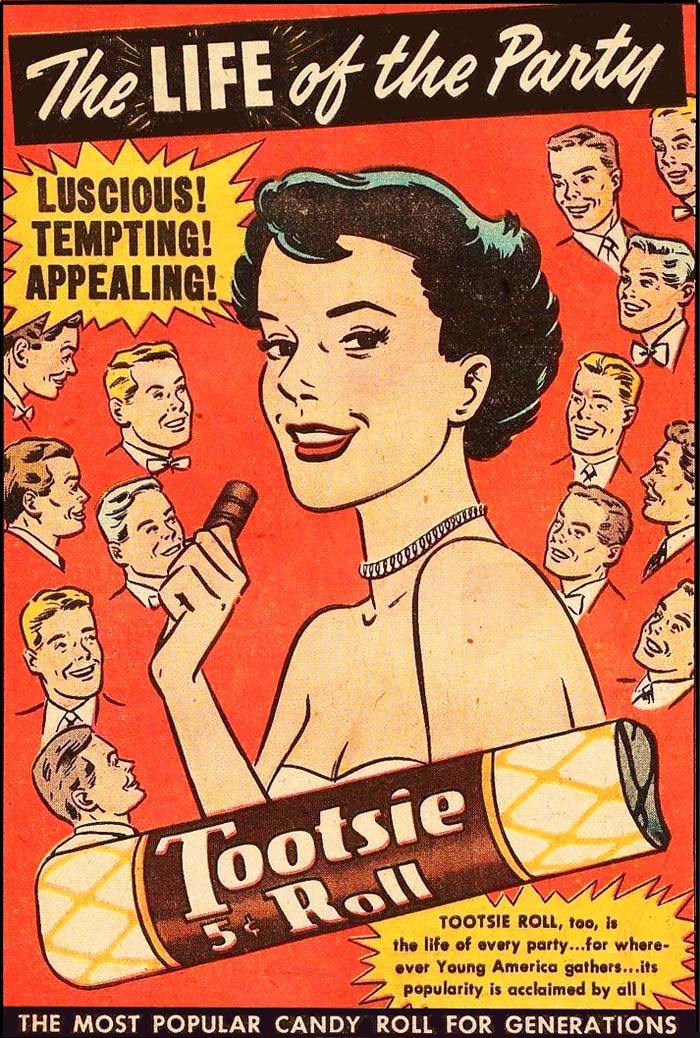
Tootsie Rolls ... who knew? (posted 6/17/21, permalink)
 Entertainer/Entrepreneur: Fifties hitmaker Lloyd Price died in May 2021 at age 88 from complications of diabetes. A self-described 'country boy', Lloyd was born on March 9, 1933, in Kenner, LA - one of 11 children of Beatrice and Louis Price, who owned the Fish 'n' Fry Restaurant. Entertainer/Entrepreneur: Fifties hitmaker Lloyd Price died in May 2021 at age 88 from complications of diabetes. A self-described 'country boy', Lloyd was born on March 9, 1933, in Kenner, LA - one of 11 children of Beatrice and Louis Price, who owned the Fish 'n' Fry Restaurant.
Price's first successful record was a solid R&B hit - 'Lawdy Miss Clawdy' - in 1952. After a stint in the military, he returned to the music scene, recording 'Stagger Lee' in 1958 as well as 'Personality' and 'I'm Gonna Get Married' in 1959.
Price was also a prolific entrepreneur. In addition to his music production and publication ownership, he started and owned businesses in various industries. He founded record labels, managed other performers, owned nightclubs and promoted boxing matches. He also owned two construction companies, erecting middle-income housing in the 1980s in the Bronx and also homes in Staten Island. He also ran a limousine company.
 He managed Lloyd Price Icon Food Brands, which makes a line of Southern-style foods, including Lawdy Miss Clawdy food products, ranging from canned greens to sweet potato cookies, and a line of Lloyd Price foods. He managed Lloyd Price Icon Food Brands, which makes a line of Southern-style foods, including Lawdy Miss Clawdy food products, ranging from canned greens to sweet potato cookies, and a line of Lloyd Price foods.
During an interview in the early 1990s with Jerry Blavat on the now-defunct Nostalgia Network, Price said that he hit a low spot in the mid-1960s - he was playing club dates and sleeping in his car to save money. Record companies offered to buy the masters and rights to his songs, but he steadfastly refused. He said that 'Personality' and 'Stagger Lee' alone were earning him royalties of $350,000 per year.
Those two recordings have also earned places on my iTunes playlist, because I listened to both in high school. When I hear them now, it makes me feel young - at least for a moment or two.
Rest in Peace, Lloyd. (posted 6/15/21, permalink)
Wiener Queen: Presenting Miss Frankfurter of 1952:
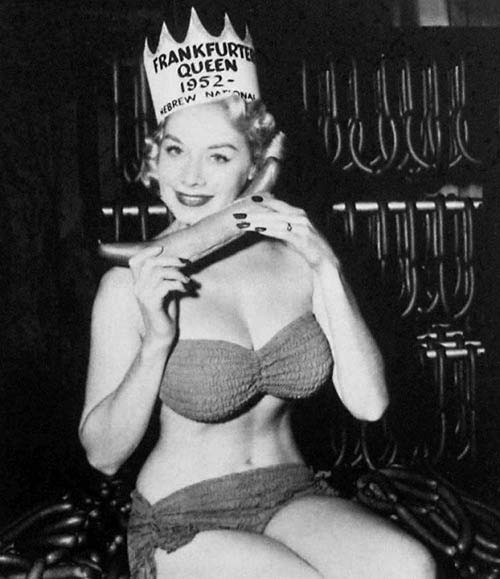
She's probably close to 90 years-old by now. (posted 6/11/21, permalink)
"A Little Dab'll Do Ya!" Brylcreem hair cream was created in 1928 by County Chemicals in Birmingham, England. Brylcreem is an emulsion of water and mineral oil stabilized with beeswax. It is notable for the high shine it provides.
It is sold worldwide and was very popular in the U.S. from the 1930s through the '60s. It was advertised on radio and television with the jingle: "Brylcreem - A Little Dab'll Do Ya! Brylcreem - You'll look so debonair. Brylcreem - The gals'll all pursue ya. They'll love to run their fingers through your hair!"
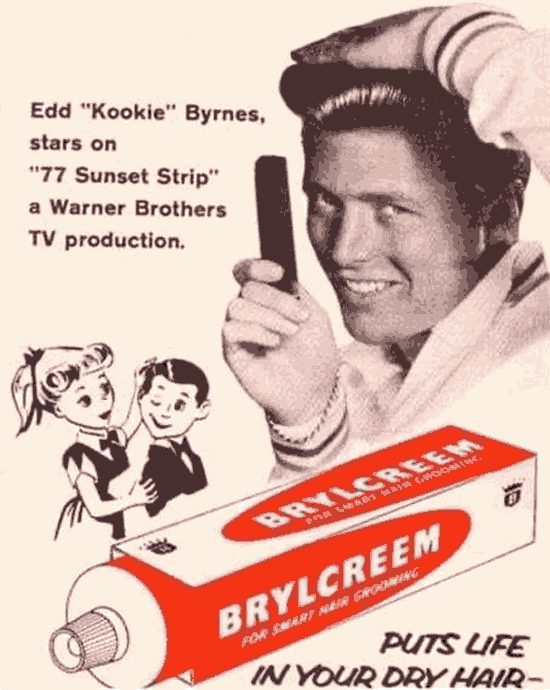
Actor Edd Byrnes appeared in print ads for Brylcreem. Byrnes became famous for his car valet, hot rodder and amateur detective character, 'Kookie' (aka: Gerald Lloyd 'Kookie' Kookson III) on the popular television series '77 Sunset Strip', which debuted in 1958. Kookie's constant onscreen tending of his ducktail haircut led to many jokes among comedians of the time, and it resulted in the 1959-charted (13 weeks) 'rap' style recording, 'Kookie, Kookie (Lend Me Your Comb)', recorded with actress and recording artist Connie Stevens. The 45-repm record sold over one million copies. Byrnes also was featured in the 1978 film 'Grease' as television teen-dance show host Vince Fontaine. Edd Byrnes died in early 2020 at age 86.

Kookie drove a hot rod built by hot rod builder and actor Norm Grabowski. Norm modified the original car several times. In 1956, he brought it to Valley Custom Shop where the car received its Royal Blue paint with flames flickering across the cowl sides. This color combination was the one seen in the TV series '77 Sunset Strip'. Grabowski's creation started the mid-1950s T-bucket craze in Southern California. T-bucket refers to a hot rod, based on a Ford Model T body of the 1915 to 1927 era. The car was nicknamed 'Kookie's Kart' and was on display at the Peterson Automotive Museum when I visited in 2002.
Dick Clark also appeared in Brylcreem print ads. (posted 6/7/21, permalink)
Another Bad Idea From The 1960s:

(I've posted more about Oreos here.)
Early Protest: For everyone who think that protests began in the 1960s, here's a 1930s woman who wants to boycott merchants with parking meters in front of their stores:
Here's another protester - this one from 1930:
On December 16th in Chicago, Miss Elizabeth Thompson was one of the first members of The Crusaders, a national organization formed to overthrow Prohibition, to put the new tire cover on her car.
She's a cutie who probably would have been fun to drink with. On the other hand, she's probably over 110 years old by now, so you probably shouldn't try phoning her for a date. On the other hand, it would be nice to drink a toast in her honor.
Thanks for helping bring back booze again, Liz. (posted 5/24/21, permalink)
"Oh Pancho!" "Oh Cisco!" If you're of a certain age, you'll probably remember those catchphases from the television series 'The Cisco Kid'. The 30 minute episodes ran from 1950 to 1955. A total of 156 episodes were filmed and each featured the Cisco Kid and his English-mangling sidekick Pancho as they traveled the old west in the grand tradition of the Lone Ranger, righting wrongs and fighting injustice wherever they found it. It was one of the few television series of the period filmed in color.

Duncan Renaldo, a Romanian-born American actor, is best remembered for his portrayal of Cisco on 'The Cisco Kid' in films and on the 1950s-era American TV series, The Cisco Kid. The Cisco Kid's horse was named Diablo. Renaldo died of lung cancer in 1980 at age 76.
Leo Carrillo played Pancho. He was an American actor, vaudevillian, political cartoonist, and conservationist. Leo was a member of the Carrillo family of California, a prominent California family, and traced his ancestry through California, Mexico, and Spain to the year 1260. Born in Los Angeles, Leo was the grandson of the Mexican Governor of California in 1837, and son of the first Mayor of Santa Monica. A university graduate, Carrillo worked as a newspaper cartoonist for the San Francisco Examiner, then turned to acting on Broadway. In Hollywood, he appeared in more than 90 films, including 'The Gay Desperado' (1936), in which he usually played supporting or character roles. Carrillo owned a 4,500-acre ranch in Carlsbad, California. After a lengthy career on the stage, beginning about 1900, he successfully made the transition to silent movies and then to talking pictures. When television came along, he scored a big hit in this medium as well.
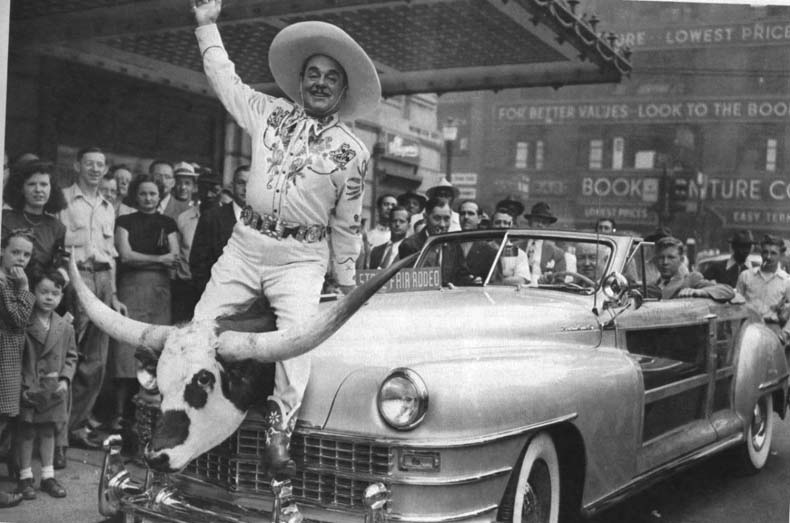
As Pancho, Carrillo rode a Palomino named Loco. Chrysler Corp. presented Mr. Carrillo with a new 1948 Chrysler Town and Country convertible, painted in a special Palomino exterior color. Carrillo had the car mildly customized, with his LC monogram/brand painted on the hubcaps and doors:
The interior and seats were customized in a longhorn theme. He also mounted a Texas longhorn head on the hood of the car. When the headlights were turned on, the longhorn's eyes would light up; they also blinked left or right to signal turns. The car's horn would bellow like a bull.
Carrillo used the car in parades, movie premieres and personal appearances to promote the television show.
Leo Carrillo died of cancer in 1961 at the age of 81. But his famous Town and Country lives on. It was owned by Harrah's for a time and later sold to the Imperial Palace. It is now in private hands. I saw it when it was displayed at the Peterson Automotive Museum and it is even more impressive in person. (posted 5/14/21, permalink)
Two Kings: In this 1950s photo, jazz/pop singer and pianist Nat King Cole squeezed into a tiny three-wheeled Messerschmitt cabin scooter, dwarfed in comparison to the 1953 Cadillac 75 limo in which his entourage is riding. Reportedly, Mr. Cole owned two Messerschmitt dealerships, one in Los Angeles.
The 111-inch long Messerschmitt seated ... (more >>>)
Nice Polish: Here's a 1957 eye-catching ad for Mac's Resin Coat Car Polish:
More 'Geezer Stuff' postings can be found here.
Other Pages Of Interest
| blog: 'The View Through The Windshield' |
| greatest hits: index of essays & articles | blog archives | '39 Plymouth |
| model train layout | about me | about the blog | e-mail |
copyright 2021 - Joseph M. Sherlock - All applicable rights reserved
Disclaimer
The facts presented on this website are based on my best guesses and my substantially faulty geezer memory. The opinions expressed herein are strictly those of the author and are protected by the U.S. Constitution. Probably.
If I have slandered any brands of automobiles, either expressly or inadvertently, they're most likely crap cars and deserve it. Automobile manufacturers should be aware that they always have the option of trying to change my mind by providing me with vehicles to test drive. I'll dutifully report my road test impressions on this car blog.
If I have slandered any people or corporations, either expressly or inadvertently, they should buy me strong drinks (and an expensive meal) and try to prove to me that they're not the jerks I've portrayed them to be. If you're buying, I'm willing to listen.
| |